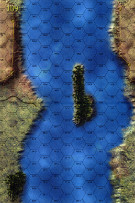|
|
|
Total |
| Side 1 |
1 |
| Draw |
0 |
| Side 2 |
1 |
|
Total |
| Side 1 |
1 |
| Draw |
0 |
| Side 2 |
1 |
|
Total |
| Side 1 |
0 |
| Draw |
0 |
| Side 2 |
0 |
|
| Overall Rating, 2 votes |
|---|
|
|
|
Scenario Rank:
--- of 957 |
| Parent Game |
River Battleships |
| Historicity |
Alt-History |
| Date |
1941-06-01 |
| Start Time |
07:00 |
| Turn Count |
20 |
| Visibility |
Day |
| Counters |
19 |
| Net Morale |
0 |
| Net Initiative |
0 |
| Maps |
2: 108, 109 |
| Layout Dimensions |
86 x 28 cm
34 x 11 in |
| Play Bounty |
157 |
| AAR Bounty |
222 |
| Total Plays |
2 |
| Total AARs |
0 |
|
Introduction
|
|
The Romanian flotilla held a serious edge in combat power over their Soviet counterparts, but didn’t try to use that to leverage the Soviets out of the Danube. Instead, the Romanians waited for the Soviets to withdraw on their own. But had the Soviet Ninth Army managed to hold its ground against the Romanian assault, the Danube Flotilla would have had to clear the big river’s lower reaches by force.
|
|
Conclusion
|
|
The big Soviet Projekt SB-57 “Shilka” type monitors, three times the displacement of the preceding Projekt SB-37 “Zhelezhnyakov” type with much heavier armor and armament, had been specifically designed to combat the Romanian monitors. All three were laid down in 1939, but none had been completed by June 1941. The Shilka class (none of them are actually named Shilka – their individual names were changed during construction, but not the class name) at first had been intended for the Amur Flotilla in the Far East, but were re-assigned to the Danube before completion. With these true river battleships in their order of battle, the Soviet Danube Flotilla might have been more willing to challenge the Romanians.
|
Display Relevant AFV Rules
| AFV Rules Pertaining to this Scenario's Order of Battle |
- Vulnerable to results on the Assault Combat Chart (7.25, 7.63, ACC), and may be attacked by Anti-Tank fire (11.2, DFT). Anti-Tank fire only affects the individual unit fired upon (7.62, 11.0).
- AFV's are activated by tank leaders (3.2, 3.3, 5.42, 6.8).
They may also be activated as part of an initial activating stack, but if activated in this way would need a tank
leader in order to carry out combat movement.
- AFV's do not block Direct Fire (10.1).
- Full-strength AFV's with "armor efficiency" may make two anti-tank (AT) fire attacks per turn
(either in their action segment or during opportunity fire) if they have AT fire values of 0 or more
(11.2).
- Each unit with an AT fire value of 2 or more may fire at targets at a distance of between 100% and 150% of its
printed AT range. It does so at half its AT fire value. (11.3)
- Efficient and non-efficient AFV's may conduct two opportunity fires per turn if using direct fire
(7.44, 7.64).
Units with both Direct and AT Fire values may use either type of fire in the same turn as their opportunity fire,
but not both (7.22, 13.0).
Units which can take opportunity fire twice per turn do not have to target the same unit both times (13.0).
- Demoralized AFV's are not required to flee from units that do not have AT fire values (14.3).
- Place a Wreck marker when an AFV is eliminated in a bridge or town hex (16.3).
- AFV's do not benefit from Entrenchments (16.42).
- AFV's may Dig In (16.2).
- River Vessels: see Rule 15.2 ~ 15.22
|
Soviet Union Order of Battle


 RiBa007
RiBa007 













